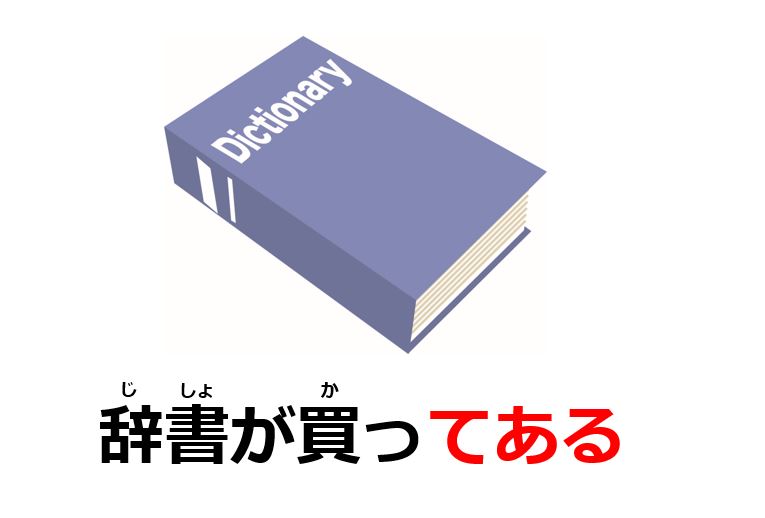Last time, you learned how to express the beginning, the middle, and the end of actions: 料理を 作り始めた・作っているところだ・作り終わった. You have almost completed Japanese tense and aspect. In this lesson, we will pick up the rest of them. And don’t worry, all of them can be expressed by using the single form: te-form.
Explanation for How to Utilize the Te-form for Various Expressions
| Table of Contents …てしまう: Complete Actions or Unintentional Actions …てある: Resultant States …ておく: Preparatory Actions …てみる: Trial Actions |
As you have already learned, the te-form can be a base for other expressions in terms of conjugation. If you attach いる to the te-form, you can express progressive tense, resultant states, customary actions, and experience. Just like that, you can express various things by attaching other phrase to the te-form.
…てしまう: Complete Actions or Unintentional Actions
| 弟は | すぐに | お菓子を | 食べて(しまった / しまいました) |
| Topic/Subject | Adverb | Direct Object | Te-form + しまう |
| [My] younger brother ate the pastry quickly and completely. | |||
The first function is to express complete actions which are something like “to do something completely,” or “to have something done.” With the example above, we have applied the ta-form for しまう, but you can use this in the future tense, too.
| 思い切って飲んで(しまう / しまいます)よ。 [I] will drink daringly. |
| すぐ片づけて(しまう / しまいます)ね。 [I] will have [it] tidied away right now. |
| 小説を一日で読んで(しまった / しまいました)。 [I] completely read the novel in a day. |
| 宿題はもうやって(しまった / しまいました)よ。 As for the homework, [I] had [it] done already. |
| [私は / が] | 窓ガラスを | 割って(しまった / しまいました) |
| [Topic/Subject] | Direct Object | Te-form + しまう |
| [I] have unintentionally broken the windowpane. | ||
The second function is to express unintentional or regrettable actions. Although this function is totally different from the first one, we use the same form. Therefore, you need to judge whether which function しまう works as.
| 泣いて(しまう / しまいます)。 [I] will unintentionally cry. |
| 怪我をして(しまう / しまいます)よ。 [You] will unintentionally injure yourself. |
| 時計を壊して(しまった / しまいました)。 [I] regrettably broke [my] watch. |
| 妹を泣かして(しまった / しまいました)。 [I] unintentionally made my younger sister cry. |
てしまう has two colloquial expressions which are じゃう and ちゃう. You don’t have to use them, but should recognize when native speakers use them to you. The point here is that the replacement needs to include て and で, i.e. てしまう => ちゃう and でしまう => じゃう.
| 泣いて(ちゃう / ちゃいます)。 |
| 時計を壊して(ちゃった / ちゃいました)。 |
| 思い切って飲んで(じゃう / じゃいます)よ。 |
| 小説を一日で読んで(じゃった / じゃいました)。 |
…てある: Resultant States
| 窓が | 開けて(ある / あります) |
| Subject | Te-form + ある |
| The window is kept open (by someone). | |
We need to explain the concept here. First of all, …てある is always used with transitive verbs. If you plainly say the example above, you would say “窓を開ける (I will open the window).” Then, the momentary action: 開ける would result in the state: 窓を開けている (I kept the window open).” This is from your point of view. What if you express the resultant state from the third person’s point of view? You can say “窓が開けてある (The window is kept open). This is the function of …てある, which expresses resultant states given by someone. When you use this, the usage of particles matters. With the plain expression, the particle を is used because you kept the window open, i.e. the window is an object. However, when you see it from the third person’s point of view, the window is already open, i.e. the window is a subject. Therefore, the standard particle is が. Then, you can replace it with は and も depending on contexts.
| 日本語の辞書が買って(ある / あります)。 A Japanese dictionary is bought (and kept). |
| 英語の辞書も買って(ある / あります)。 An English dictionary is also bought (and kept). |
| 中国語の辞書は買って(いない / いません)。 A Chinese dictionary is not bought. |
When transitive verbs have its counterparts in intransitive verbs. They can express very similar things. The difference is …てある implies that actions are taken by someone. Let’s see the comparison: 開く (intransitive) + te-form + いる vs. 開ける (transitive) + te-form + ある.
| 窓が開いて(いる / います)。 The window is open. |
| 窓が開けて(ある / あります)。 The window is kept open (by someone). |
There is a usage to use the particle を. That way, you generally express resultant states with a nuance of preparation. In this context, doers are subjects. The followings are examples in conversation.
| Q. How do you start studying Japanese? |
| [私は] 日本語の辞書を買って(ある / あります)。 [I] bought a Japanese dictionary (for studying Japanese). |
| Q. Durian will strongly smell. Can I take it from the box? |
| (うん / はい)、[田中さんが] 窓を開けて(ある / あります)。 Yes, Tanaka-san have opened the window (for letting the smell go out). |
[adsense]
…ておく: Preparatory Actions
| [私は / が] | パンを | 買って(おく / おきます) |
| [Topic/Subject] | Direct Object | Te-form + おく |
| [I] will buy breads (for the future). | ||
The function is to express preparatory actions for the future. As you may notice, the meaning is very similar to てある with the particle を.
| テストの復習をして(おく / おきます)。 [I] will review the test (for the future). |
| 車の修理をして(おく / おきます)。 [I] will repair the car (for the future). |
| 昨日はたくさん寝て(おいた / おきました)。 [I] slept a lot yesterday (for the future). |
| 日本語の辞書を買って(おいた / おきました)。 [I] bought a Japanese dictionary (for the future). |
Difference between ておく and てある
| 日本語の辞書を買って(おいた / おきました)。 |
| 日本語の辞書を買って(ある / あります)。 |
Both of them essentially express “[I] bought a Japanese dictionary (for the future).” With the example of ておく, you have applied the ta-form for it. However, you don’t need to do so for …てある. It is because …てある indicates resultant states while ておいた indicates preparatory actions in the past.
| 辞書を買って(おく / おきます)。 [I] will buy a dictionary (for the future). |
| 辞書を買って(ある / あります)。 [I] bought a dictionary (for the future). |
…てある is not suitable for expressing future tense because the form is exactly same as the one for past tense and just indicates states when momentary actions are already done (=resultant states).
…てみる: Trial Actions
| [私は / が] | 寿司を | 食べて(みた / みました) |
| [Topic/Subject] | Direct Object | Te-form + みる |
| [I] tried to eat Sushi. | ||
The function is to express trial actions. This can be translated as “try to do” or “try something out” in English.
| 日本の地図を買って(みる / みます)。 [I] will try to buy a map of Japan. |
| 映画を見て(みる / みます)。 [I] will try to watch a movie. |
| 漢字を書いて(みた / みました)。 [I] tried to write kanji. |
| 日本語能力試験を受けて(みた / みました)。 [I] tried to take JLPT. |
Summary
- …てしまう expresses complete actions, or unintentional or regretful actions.
- …てある expresses resultant states.
- …ておく expresses preparatory actions.
- …てみる expresses trial actions.
From the above, you can see how important the te-form is. By utilizing the te-form, you can express a variety of things. We know the conjugation is not easy, but please try to memorize it properly. You will learn more and more uses in upcoming lessons. And so ends the last lesson in the tense and aspect section. Great job!





